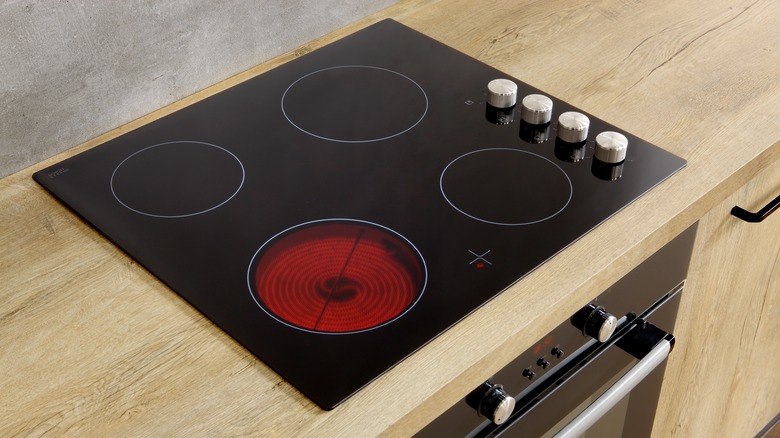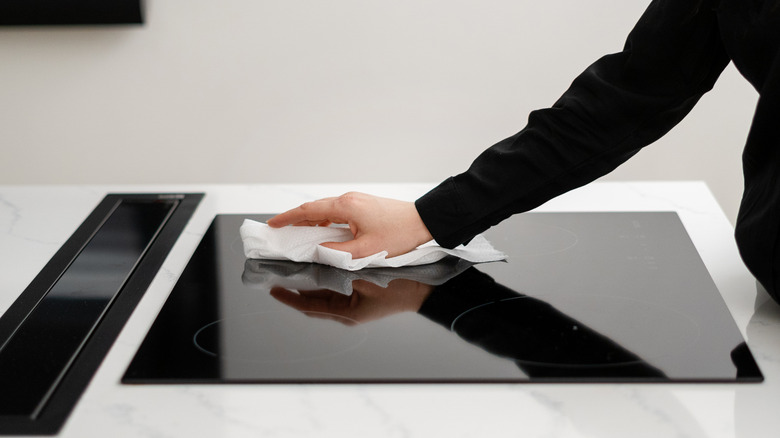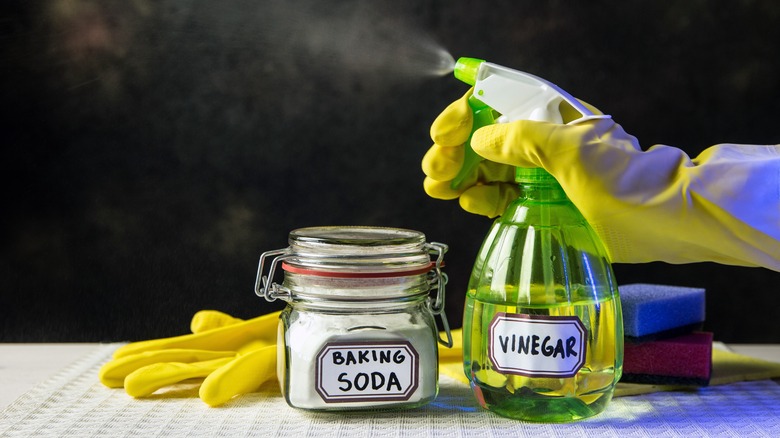The Common Mistake To Avoid When Cleaning Your Glass Stovetop
By now you've probably heard that gas stoves will soon become a thing of the past, which means that most new stoves will either use electric or induction burners instead of propane. A glass- or ceramic-topped electric stove is a great option because it looks sleek, and it's easy to clean compared to models with exposed coils. Just because it's made out of glass doesn't mean you can treat it — or clean it — like a window, however. In fact, one of the most common mistakes people make with glass stovetops is cleaning them with ammonia-based cleaners.
Glass cleaners that are made for windows tend to use ammonia because it dries extremely quickly, so it doesn't leave streaks behind. That's great for cleaning clear glass or mirrors, but it's a different story with the tempered, treated surface of a stovetop. In fact, ammonia-based cleaners can cause permanent streaks on glass and ceramic stovetops, which can ruin their modern-looking facade. Not only that, window cleaners with ammonia will release toxic fumes if they get hot, which can make you sick.
You don't need special cleaners
While most of us reach for the Windex (or any other glass cleaning agent with some ammonia) when it's time to wipe down a mirror or window, it's not a great choice when it comes to your glass stovetop. This is because not all glass is the same, and ammonia can be too harsh on more delicate surfaces. Most of the windows and mirrors that you have in your house are made with float glass, which is more impervious to scratching. Stoves, on the other hand, are made with tempered ceramic glass, which allows it to withstand high heat without cracking. While it's stronger when it's exposed to heat, it's more vulnerable when it's exposed to harsh chemicals like ammonia, bleach, and metal-based scrubbers. Plus, it's easy to etch the surface or leave permanent streaks. Not only can ammonia cause damage to your stove, it can even invalidate your factory warranty. Also, if you spray ammonia-based cleaner onto a hot stove, it will release toxic fumes into the air that can irritate your eyes, nose, and throat.
Naturally, there are products specifically made for cleaning glass and ceramic stovetops. If you're a cleaning product person, look for those in the cleaning section of the grocery or hardware store. You don't need to buy anything fancy, though, because you can easily get the job done with a little baking soda and white vinegar.
Steps for cleaning a glass stove
Cleaning a glass-topped stove with vinegar and baking soda is easy, you just need to follow a few simple steps. First, let the stove cool down to the point where you can touch it. Then, spray the surface with a thin coat of vinegar and sprinkle some baking soda on top. Cover everything with a hot, wet towel soaked with some more vinegar and let it sit for about 10 minutes to dissolve any residue clinging to the glass. Finally, take the towel off and wipe away all the gunk. If you see any streaks you can spray clean the stove's surface with a little more vinegar. It also helps to wipe everything down with a microfiber towel.
The best way to clean your stove, however, is to keep it from getting too dirty in the first place. Before you shut down the kitchen after dinner, which gives the stove some time to cool off, wipe down the glass surface so that stains and residue don't dry on the surface. You can use either a couple of damp paper or kitchen towels and some white vinegar, or a wet, soapy sponge. Not only will that keep your stove looking good and scratch-free, but you won't expose yourself to any harmful ammonia fumes either.


